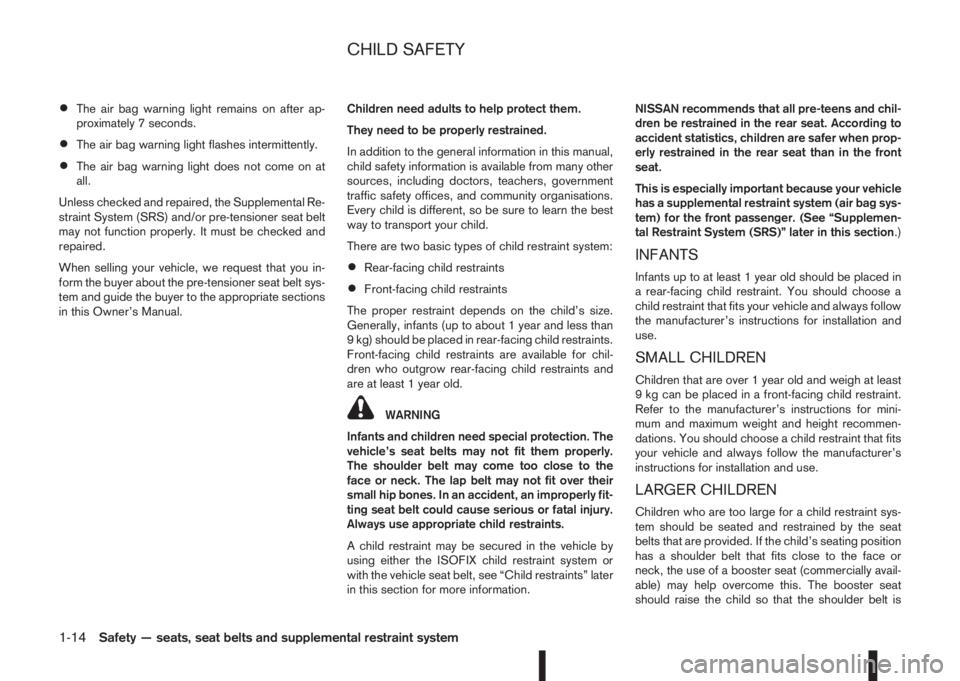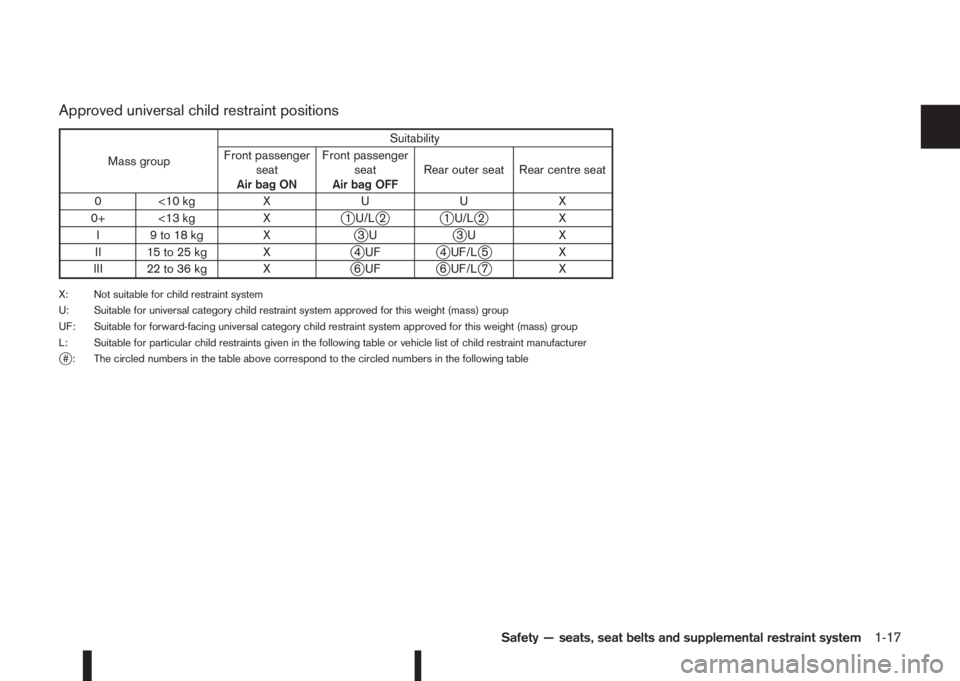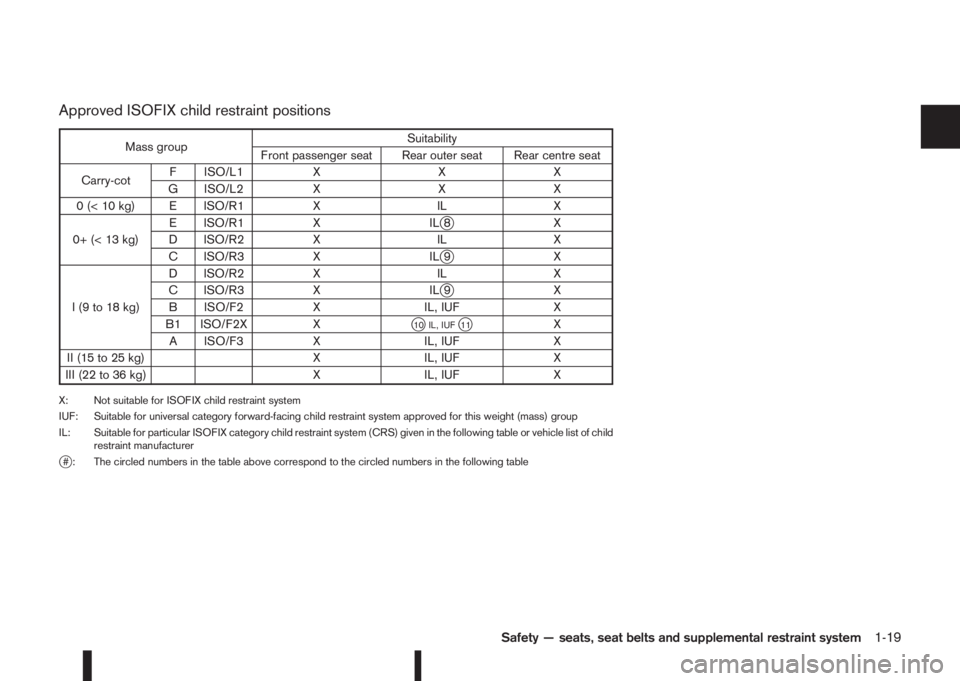2014 NISSAN QASHQAI weight
[x] Cancel search: weightPage 34 of 338

•The air bag warning light remains on after ap-
proximately 7 seconds.
•The air bag warning light flashes intermittently.
•The air bag warning light does not come on at
all.
Unless checked and repaired, the Supplemental Re-
straint System (SRS) and/or pre-tensioner seat belt
may not function properly. It must be checked and
repaired.
When selling your vehicle, we request that you in-
form the buyer about the pre-tensioner seat belt sys-
tem and guide the buyer to the appropriate sections
in this Owner’s Manual.Children need adults to help protect them.
They need to be properly restrained.
In addition to the general information in this manual,
child safety information is available from many other
sources, including doctors, teachers, government
traffic safety offices, and community organisations.
Every child is different, so be sure to learn the best
way to transport your child.
There are two basic types of child restraint system:
•Rear-facing child restraints
•Front-facing child restraints
The proper restraint depends on the child’s size.
Generally, infants (up to about 1 year and less than
9 kg) should be placed in rear-facing child restraints.
Front-facing child restraints are available for chil-
dren who outgrow rear-facing child restraints and
are at least 1 year old.
WARNING
Infants and children need special protection. The
vehicle’s seat belts may not fit them properly.
The shoulder belt may come too close to the
face or neck. The lap belt may not fit over their
small hip bones. In an accident, an improperly fit-
ting seat belt could cause serious or fatal injury.
Always use appropriate child restraints.
A child restraint may be secured in the vehicle by
using either the ISOFIX child restraint system or
with the vehicle seat belt, see “Child restraints” later
in this section for more information.NISSAN recommends that all pre-teens and chil-
dren be restrained in the rear seat. According to
accident statistics, children are safer when prop-
erly restrained in the rear seat than in the front
seat.
This is especially important because your vehicle
has a supplemental restraint system (air bag sys-
tem) for the front passenger. (See “Supplemen-
tal Restraint System (SRS)” later in this section.)
INFANTS
Infants up to at least 1 year old should be placed in
a rear-facing child restraint. You should choose a
child restraint that fits your vehicle and always follow
the manufacturer’s instructions for installation and
use.
SMALL CHILDREN
Children that are over 1 year old and weigh at least
9 kg can be placed in a front-facing child restraint.
Refer to the manufacturer’s instructions for mini-
mum and maximum weight and height recommen-
dations. You should choose a child restraint that fits
your vehicle and always follow the manufacturer’s
instructions for installation and use.
LARGER CHILDREN
Children who are too large for a child restraint sys-
tem should be seated and restrained by the seat
belts that are provided. If the child’s seating position
has a shoulder belt that fits close to the face or
neck, the use of a booster seat (commercially avail-
able) may help overcome this. The booster seat
should raise the child so that the shoulder belt is
CHILD SAFETY
1-14Safety — seats, seat belts and supplemental restraint system
Page 37 of 338

Approved universal child restraint positions
Mass groupSuitability
Front passenger
seat
Air bag ONFront passenger
seat
Air bag OFFRear outer seat Rear centre seat
0 <10 kg X U U X
0+ <13 kg X
j1 U/Lj2j1 U/Lj2X
I 9 to 18 kg X
j3Uj3U X
II 15 to 25 kg X
j4UFj4 UF/Lj5X
III 22 to 36 kg X
j6UFj6 UF/Lj7X
X: Not suitable for child restraint system
U: Suitable for universal category child restraint system approved for this weight (mass) group
UF: Suitable for forward-facing universal category child restraint system approved for this weight (mass) group
L: Suitable for particular child restraints given in the following table or vehicle list of child restraint manufacturer
j# : The circled numbers in the table above correspond to the circled numbers in the following table
Safety — seats, seat belts and supplemental restraint system1-17
Page 39 of 338

Approved ISOFIX child restraint positions
Mass groupSuitability
Front passenger seat Rear outer seat Rear centre seat
Carry-cotF ISO/L1 X X X
G ISO/L2 X X X
0 (< 10 kg) E ISO/R1 X IL X
0+ (< 13 kg)E ISO/R1 X IL
j8X
D ISO/R2 X IL X
C ISO/R3 X IL
j9X
I(9to18kg)D ISO/R2 X IL X
C ISO/R3 X IL
j9X
B ISO/F2 X IL, IUF X
B1 ISO/F2X X
j10 IL, IUFj11X
A ISO/F3 X IL, IUF X
II (15 to 25 kg) X IL, IUF X
III (22 to 36 kg) X IL, IUF X
X: Not suitable for ISOFIX child restraint system
IUF: Suitable for universal category forward-facing child restraint system approved for this weight (mass) group
IL: Suitable for particular ISOFIX category child restraint system (CRS) given in the following table or vehicle list of child
restraint manufacturer
j# : The circled numbers in the table above correspond to the circled numbers in the following table
Safety — seats, seat belts and supplemental restraint system1-19
Page 127 of 338

•A buzzer will sound if the vehicle is driven
without releasing the parking brake. See “Au-
dible reminders” in the “2. Instruments and
controls” section.
•While the electric parking brake is applied or
released, an operating sound is heard from
the lower side of the rear seat. This is normal
and does not indicate a malfunction.
•When the electric parking brake is frequently
applied and released in a short period of time,
the parking brake may not operate in order to
prevent the parking brake system from over-
heating. If this occurs, operate the electric
parking brake switch again after waiting ap-
proximately 1 minute.
•The electric parking brake can only be re-
leased with the ignition switch in the ON posi-
tion.
•If the electric parking brake must be applied
while driving in an emergency, pull up and
hold the parking brake switch. When you re-
lease the parking brake switch, the parking
brake will be released.
•While pulling up the electric parking brake
switch while driving, the parking brake is ap-
plied and a chime sounds. The parking brake
indicator light in the meter and in the parking
brake switch illuminate. This does not indi-
cate a malfunction. The electric parking brake
indicator lights in the meter and in the parking
brake switch turn off when the parking brake
is released.
•Pull up the electric parking brake switch twice
so that the maximum electric parking brake
force is applied to the vehicle.
•When pulling the electric parking brake switch
up with the ignition switch in the OFF or ACC
position, the parking brake switch indicator
light will continue to illuminate for a short pe-
riod of time.
CAUTION
To park the vehicle in cold climates place the
shift lever in 1st (1) or Reverse (R) (or in Park (P)
for automatic (AT) vehicles), and place suitable
chocks at both the front and back of a wheel with
the electric parking brake released. If the electric
parking brake is applied in cold climates, the
brake may become frozen and cannot be re-
leased.
DRIVING AWAY WHEN TOWING A
TRAILER
Please note the following points to prevent the ve-
hicle from rolling back unintentionally on a gradient.
•Pull and hold the parking brake switch and press
the accelerator. The parking brake will remain
engaged and prevent any tendency to roll back
down the slope.
•You can release the parking brake switch as
soon as the engine is delivering enough power
to the wheels.
Depending on the weight of the vehicle and trailer
and the steepness of the slope, there may be a ten-dency to roll back downhill when driving away from
a standstill. You can prevent this by pulling up the
parking brake switch as you press the accelerator
(in the same way as with a conventional handbrake).
Pre-driving checks and adjustments3-17
Page 230 of 338

Your new vehicle was designed to be used primarily
to carry passengers and luggage.
Remember that towing a trailer will place additional
loads on your vehicle’s engine, drive-train, steering,
braking and other systems. Towing a trailer will also
exaggerate other conditions, such as sway caused
by crosswinds, rough road surfaces or passing
trucks. Driving style and speed must be adjusted
according to the circumstances. Before towing a
trailer, see a NISSAN dealer or qualified workshop
for an explanation of towing equipment and its
proper use.
OPERATING PRECAUTIONS
•Avoid towing a trailer during the running-in
schedule.
•Choose proper coupling devices (trailer hitch,
safety chain, roof carrier, etc.) for your vehicle
and trailer. These devices are available from a
NISSAN dealer or qualified workshop where you
can also obtain more detailed information about
trailer towing.
Heavy-duty kits are available at a NISSAN dealer
or qualified workshop.
•It is advisable to contact a NISSAN dealer or
qualified workshop for towing details, before
towing a trailer up steep slopes for long dis-
tances.
•Never allow the total trailer load (trailer weight
plus its cargo weight) to exceed the maximum
set for the coupling device.Contact a NISSAN dealer or qualified workshop
for more information on this matter.
•The trailer must be loaded so that heavy goods
are distributed over the axle and as low in the
trailer as possible. Poor load distribution can se-
riously affect the stability of the trailer and tow
vehicle.
•Do not exceed the maximum permitted vertical
load on the trailer hitch.
•Before driving, make sure that the lighting sys-
tem of the trailer works properly.
•When towing with 4WD models, the 4WD mode
switch should be in the AUTO position. Using
the vehicle in AUTO mode gives better traction,
particularly when moving off from stationary and/
or on an incline, as the vehicle is less likely to
wheel spin.
•Avoid abrupt starts, accelerations and stops.
•Avoid sharp turns and lane changes.
•Always drive your vehicle at a moderate speed.
•Always block the wheels on both vehicle and
trailer when parking. Apply the handbrake (where
fitted) on the trailer. Parking on a steep slope is
not recommended.
If parking on a steep slope is unavoidable it is
also advisable to put the vehicle into gear, or
select P (Park (XTRONIC models)), and turn the
front wheels into the kerb (in addition to the other
precautions described). Before parking on asteep slope consider the incline (the towing
weights quoted are for a 12% slope).
•Follow the trailer manufacturer’s instructions.
•Have your vehicle serviced more often than at
the intervals specified in the separately provided
Warranty Information and Maintenance booklet.
•Trailer towing requires more fuel than under nor-
mal circumstances because of a considerable
increase in traction power required and resis-
tance.
•When towing a trailer, observe the following re-
stricted towing speed:
Speed: below 100 km/h (62 MPH)
•Observe the legal maximum speeds for trailer
operation.
CAUTION
While towing a trailer, check the engine coolant
temperature gauge regularly to prevent engine
overheating.
NSD239Z
TRAILER TOWING
5-54Starting and driving
Page 231 of 338

jATongue load
jBTotal trailer load
jCLess than 10%
MAXIMUM LOAD LIMITS (for Australia)
Maximum trailer loads (including tyres and other
loaded equipment):
1) Never allow the total trailer load to exceed:
Engine –
TransmissionAxle Towing capacity
R9M – CVT 2WD750 kg Trailer without brakes
1400 kg Trailer with brakes
MR20DD – 6MT 2WD716 kg Trailer without brakes
1400 kg Trailer with brakes
MR20DD – CVT 2WD727 kg Trailer without brakes
1200 kg Trailer with brakes
2) The total trailer load must be lower than the fol-
lowing three values, even if it does not exceed
the maximum permissible trailer load:
•Towing capacity displayed on a tow-bar.
•Trailer’s gross vehicle mass marked on a
coupling body.
•Gross vehicle mass marked on a trailer data
plate.
The maximum trailer load that can be towed by your
vehicle depends on the towing equipment fitted to
the vehicle. Therefore, it is important to not only
have the correct equipment fitted, but also to use it
correctly. Towing loads greater than the value speci-
fied for your vehicle or using towing equipment thatis not provided by NISSAN could seriously affect
the handling and/or performance of your vehicle.
Vehicle damage resulting from improper towing pro-
cedures is not covered by NISSAN warranties. In-
formation on trailer towing and the required equip-
ment should be obtained from a NISSAN dealer or
qualified workshop.
Maximum rear gross axle weight
The rear gross axle weight must not exceed the
Gross Axle Weight Rating (GAWR).
Engine – Transmission Axle GAWR
R9M – CVT 2WD 1015 kg
MR20DD – 6MT 2WD 985 kg
MR20DD – CVT 2WD 1000 kg
The trailer must be loaded so that heavy goods are
placed over the axle.
Maximum tongue load
Never allow the tongue load to exceed 10% of the
total trailer load. If the tongue load exceeds 10%,
rearrange the cargo in the trailer.
TYRE PRESSURE
When towing a trailer, inflate the vehicle tyres to the
maximum recommended COLD tyre pressure, as
indicated on the tyre placard (for full loading). Make
sure the trailer tyre pressures are correct.
CAUTION
Do not tow a trailer when the vehicle is installed
with a temporary-use spare tyre.
SAFETY CHAINS
Always use a suitable chain between the vehicle
and trailer. The chain should be attached to the hitch
and not to the vehicle bumper or axle. Be sure to
leave enough slack in the chain to permit turning
corners. The chain should not drag on the ground:
passing the chain across the trailer hitch may be the
best practice depending on your trailer.
TRAILER BRAKES
Ensure that trailer brakes are installed as required
by local regulations. Also check that all other trailer
equipment conforms to local regulations.
CA0050Z
Starting and driving5-55